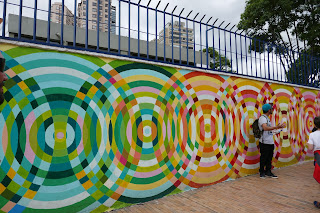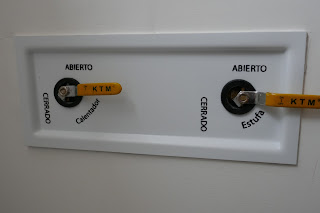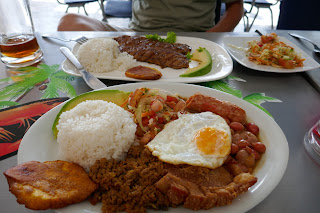 |
| Brotherly love, Galapagos Iguana Style. |
 |
| Galapagos Blowhole |
1. I AM FACE BLIND. Stuck at port in San Cristobal, Galapagos, most of our boat's guests were seated together at a local cafe near the harbor waiting for our guide and a few new guests to join. A random dude walked up and asks if anyone speaks Spanish. I say, confidently, "Si!" He then says we all need to go get in the lancha (dinghy) to go to the boat. I tell him we are still waiting for more passengers from the airport and our guide. He insists. Immediately, I am convinced it is a scam. I demand, "Todo? Que barco?" He looks at me oddly and says, "El Barco." I say, again, "Que Barco?" He repeats, less confidently, "El Barco..." Then he walks off. E asks what that was all about and I say, "that man was obviously trying to scam us into getting on a random boat." (HaHa!) "No," E says, "that is totally one of the crew... we should probably go get on the lanchas." E is right... (Sheepish)
 |
| Chaufa = Peruvian Fried Rice, Chinese Style |
2. WE MAY NEED TO CHECK INTO A WESTERN HOTEL WITHOUT A RESERVATION. I insisted that I could handle getting us into our AirBNB in Quito after 11 PM (2 hour flight delay) in a deserted area of town despite limited information from our host (now that we're serial SouthAmerican AirBNBers I realized he was just a bad host and not helpful, but at the time, I figured it was my job to know how to navigate the sketchy city in Spanish in the dark). Our taxi driver was a saint and after asking multiple people in the street and bothering multiple doormen of multiple buildings, we finally make our way in. (My ability to ask for directions, describe buildings and landmarks, and ask for help in Spanish gets *much* better in the face of a potential no-lodging situation.)
 |
| Chifa = Chinese food in Peru (Chi Fan pronounced in Spanish) |
3. LAUNDRY. Turns out, laundry in the US and Canada is *very* reasonably priced and accessible for travelers -- we typically paid $10US in laundrymats to wash and dry all of our clothes during our road trip. Incorrectly, we brought this general assumption with us to South America. So far we'd paid $16 to have our laundry washed and folded on the trail in Peru, and then dealt with the insane AirBNB laundry situation in Quito to do it ourselves ($5 more per night for a unit with laundry = $15).
In Bogota, I figured we could find a laundromat and do our own laundry. (Hah!) We sort of found what looked like one, so walked there with a big backpack of dirty laundry on E's back. Upon arrival, we realized it was a place that *did* laundry, so we asked how much it would be to wash it all. It depends. Hmmms and hawwws, and then piece-by-piece we are written a receipt, where each item has a price (roughly 1,000 Colombian Pesos per pair of underwear, 2,000 per pair of socks, 10,000 per pair of shorts or pants, 7,000 per shirt (discounted from 9,000 due to the bulk)) -- I got a lesson in the local name for every single item of clothing we owned!
Eventually, we are quoted roughly $86US to wash, dry, fold and deliver a single back-pack full of laundry. We are shocked -- everything else in this country is so much more reasonable than the US. After confirming that we are not talking about dry-cleaning, and convincing them (I think) that we *have* to have it delivered the next day, we accept the quoted price. It's till 2X lower than what our hotel would charge. Also, after all of the research and vocabulary study to make laundry work, we don't have time to find another options, we have no clean clothes left, and our flight out is the morning after scheduled delivery. Bonus, my phone Spanish improved from the multiple phones calls to confirm they were actually going to deliver our clothes when they don't show up at the scheduled time -- every time I called, I was assured they were coming "Ahora" -- and, in keeping with South American time, they eventually arrived after we'd waited in the lobby for 1.5 hours.
 |
| Dragon and Lion Dancing Performance at Lima Plaza San Martin |
We'd been in Rosario, Argentina for a few nights and I've been trying to wrap my head around yet another accent (seriously? Could Spanish pronunciation be any more insane? Xa/Sha for lla?), when I find a local chain that actually offers pedicurias (what I'm looking for, just some clean up and a paint job), not to be confused with podologias, which are apparently much more medical-ish and generally offered in connection with depilation and/or cellulite treatment.
I roll in to the pedicuria place at 5 or so (excited to have found one because these Argentinians love them some manicures, but pedicures do not seem to be super common), only to be told that they are appointment only (I think). Fine, I make an appointment for tomorrow at noon (I guessed correctly).
 |
| The Mercado de Mariscos in Panama. |
They are so nice and friendly (the male hairdresser asked me if I would take him back to California in my luggage and it took me about 5 times of him making the request before I finally decipher it), so I tell them to go ahead and I *finally* get a very basic pedicure for $20 USD (should have been $10, but I was so happy to finally accomplish this goal that I didn't even mind the lack of change).
 |
| Argentinian food is the best. Provoleta = A HUNK OF GRILLED CHEESE. |
Eventually, a very patient clerk thoroughly explains that we can choose to charge our groceries in one charge or in up to 6 monthly charges and that this is built into their checkout system. Minds blown, we are processing this information and trying to decide whether to take advantage of it when a very helpful woman in line behind us explains that she doesn't think American cards allow this -- she is right, and this explains so much of the confusion we'd been experiencing and why sometimes when we'd checked out in the past, something had happened, the card hadn't worked, then they confirmed that we want to pay for it all ("Si, todo") and then it worked. We just figured since it's a crapshoot as to which cards work when, this was all credit card wonkiness, but it turns out, it's the cuotas!
The very next time we go to the grocery store, the lady in front of us asks if she can have our grocery points. We say yes, she gives the checker her points number, and we *finally* execute the grocery check out sequence in full, perfectly. Took us more than a month, but we finally got here.
 |
| Yesterdays shared lunch plate and salad (also today's lunch of leftovers) |





























































